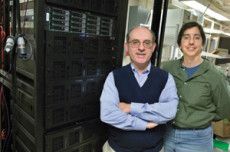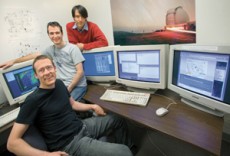Star-Gazing Across an Ocean: the Keck Remote Observing Facility
March 16, 2007
by Paul Preuss

Front row, Microsoft's Catharine van Ingen (left) and Stuart Ozer. Second row (l-r) Matt Rodriguez, Deb Agarwal, and Monte Good with the Computational Research Division.
Hawaii, Feb. 21, 3:30 in the morning: Nao Suzuki and Rahman Amanullah, two Berkeley Lab postdocs, are chasing supernovae, using one of the twin Keck telescopes on Mauna Kea. An observing assistant (OA) occasionally dashes out of the control room into the frigid air, 4,205 meters above sea level, to guess at the changing weather.
All night the sky has been veiled with broken cirrus, shrouding the night’s original targets: candidate Type Ia supernovae, the standard candles the Supernova Cosmology Project uses to measure the expansion history of the universe. Suzuki and Amanullah have had to turn to brighter objects, the host galaxies of nearby supernovae, visible through the clouds.
Two hours before dawn the sky begins to clear. Amanullah reaches for the chart for 07D3cc, a candidate found days earlier by the SuperNova Legacy Survey (SNLS). After three lengthy exposures — each unfortunately dimmer than the one before it — dawn brightens the sky. Is the spectrum bright enough to identify the type and redshift of 07D3cc? The answer will have to wait for data analysis.
So ended a typical midwinter night of observing, with one wrinkle: neither observer was at the telescope. Suzuki was sitting in Keck Headquarters in Waimea, a town 32 kilometers from the summit, and Amanullah was 3,800 kilometers away in Berkeley Lab’s Keck Remote Observing Facility, a windowless room deep in the bowels of Bldg. 50B.

On the night of Feb. 20, Nao Suzuki was the only Berkeley Lab observer in Hawaii
Virtual Network Computing (VNC) windows, running simultaneously in all three locations, controlled the settings of the telescope and its instruments. With a few clicks on the keyboard, either Suzuki in Waimea or Amanullah in Berkeley could change filters, set exposure times, open the spectrograph’s shutters and, with the OA’s cooperation, move the 300-ton telescope to pinpoint a distant supernova in a field of stars.
Tony Spadafora of the Physics Division is the project’s scientific coordinator. “Not so long ago we’d have to send two or three people to Hawaii for one night’s observing,” he says. “Now we send one.”
Deb Agarwal and Craig Leres of the Computational Research Division built the system. The Keck’s remote-operations coordinator Bob Kibrick of UC Santa Cruz provided the guidelines: the remote observing room can be used for no other purpose, and communications with the telescope have to be over a dedicated subnet, firewalled from possible interference. By using spare high-resolution monitors and multi-monitor graphics cards, Agarwal and Leres were able to get the system up and running in just two weeks in October, 2005.
Some of the Keck’s remote observing sites in California are designated “mainland only,” meaning nobody needs to go to Hawaii. Berkeley Lab operates in “eavesdrop” mode: an expert observer must be present in Waimea. Mainland-only status will require new equipment, including back-up communications. Even in eavesdrop mode the facility has benefited both the Lab and UC Berkeley.
“Most important has been training students,” says Spadafora. “Another enormously helpful aspect has been the availability to campus astronomers.”
Whether 32 kilometers away or 3,800, remote observing presents its own challenges. When setup for the night of Feb. 20-21 began at 2 p.m. Hawaii time, 4 p.m. in Berkeley, the Virtual Network Computing windows were not responding.
In Berkeley, Agarwal was at the keyboard and on the phone with UCSC’s Kibrick. “There are various ways to start the VNC servers,” she explained later. “The method they chose that night did not leave them in a functional state.” Kibrick taught the observers how to fix the problem if it ever recurs.
Spadafora and Physics postdoc Kyle Dawson were also in the tiny room. Dawson, trained on the Keck and the remote facility’s most experienced observer, was there to introduce Amanullah to its operation. Joshua Meyers, a graduate student Dawson had recruited into the Supernova Cosmology Project, would analyze the supernova data acquired that night.
With the VNCs operational again, Dawson in Berkeley and Suzuki in Waimea discussed target options, given the iffy weather. Once advance preparations were finished, Amanullah was on his own.

Tony Spadafora is scientific coordinator of the Lab�s Remote Observing Facility, which was assembled by Deb Agarwal
“Winter nights are longer, but on Mauna Kea February is the worst month for weather,” says Suzuki. “Even with high-tech instruments, ground-based telescopes are always fighting the weather.” Despite the difficulties, he and Amanullah hoped they had captured an early morning prize, SNLS candidate 07D3cc.
Back in Berkeley, Suzuki and Meyers converted the raw data into a faint spectrum. Meyers says, “I cycled through every supernova template I had” — some 350 individual templates — “and found the best match.” Supernova 07D3cc was indeed a Type Ia, with a redshift of 0.7, roughly nine and a half billion light years away.
SNLS is constructing a Hubble diagram showing the history of the expansion of the universe, which will include 500 Type Ia supernovae. Says Suzuki, “This hard-won supernova is going to be one data point among those 500.”
About Computing Sciences at Berkeley Lab
High performance computing plays a critical role in scientific discovery. Researchers increasingly rely on advances in computer science, mathematics, computational science, data science, and large-scale computing and networking to increase our understanding of ourselves, our planet, and our universe. Berkeley Lab’s Computing Sciences Area researches, develops, and deploys new foundations, tools, and technologies to meet these needs and to advance research across a broad range of scientific disciplines.







 Instagram
Instagram YouTube
YouTube